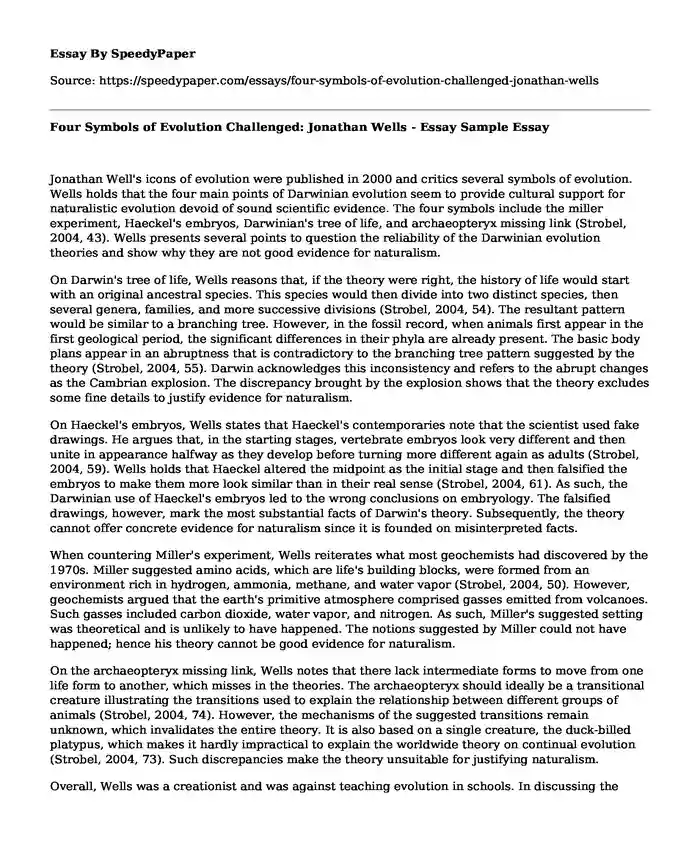
| Type of paper: | Essay |
| Categories: | Education Literature Writers |
| Pages: | 3 |
| Wordcount: | 600 words |
Jonathan Well's icons of evolution were published in 2000 and critics several symbols of evolution. Wells holds that the four main points of Darwinian evolution seem to provide cultural support for naturalistic evolution devoid of sound scientific evidence. The four symbols include the miller experiment, Haeckel's embryos, Darwinian's tree of life, and archaeopteryx missing link (Strobel, 2004, 43). Wells presents several points to question the reliability of the Darwinian evolution theories and show why they are not good evidence for naturalism.
On Darwin's tree of life, Wells reasons that, if the theory were right, the history of life would start with an original ancestral species. This species would then divide into two distinct species, then several genera, families, and more successive divisions (Strobel, 2004, 54). The resultant pattern would be similar to a branching tree. However, in the fossil record, when animals first appear in the first geological period, the significant differences in their phyla are already present. The basic body plans appear in an abruptness that is contradictory to the branching tree pattern suggested by the theory (Strobel, 2004, 55). Darwin acknowledges this inconsistency and refers to the abrupt changes as the Cambrian explosion. The discrepancy brought by the explosion shows that the theory excludes some fine details to justify evidence for naturalism.
On Haeckel's embryos, Wells states that Haeckel's contemporaries note that the scientist used fake drawings. He argues that, in the starting stages, vertebrate embryos look very different and then unite in appearance halfway as they develop before turning more different again as adults (Strobel, 2004, 59). Wells holds that Haeckel altered the midpoint as the initial stage and then falsified the embryos to make them more look similar than in their real sense (Strobel, 2004, 61). As such, the Darwinian use of Haeckel's embryos led to the wrong conclusions on embryology. The falsified drawings, however, mark the most substantial facts of Darwin's theory. Subsequently, the theory cannot offer concrete evidence for naturalism since it is founded on misinterpreted facts.
When countering Miller's experiment, Wells reiterates what most geochemists had discovered by the 1970s. Miller suggested amino acids, which are life's building blocks, were formed from an environment rich in hydrogen, ammonia, methane, and water vapor (Strobel, 2004, 50). However, geochemists argued that the earth's primitive atmosphere comprised gasses emitted from volcanoes. Such gasses included carbon dioxide, water vapor, and nitrogen. As such, Miller's suggested setting was theoretical and is unlikely to have happened. The notions suggested by Miller could not have happened; hence his theory cannot be good evidence for naturalism.
On the archaeopteryx missing link, Wells notes that there lack intermediate forms to move from one life form to another, which misses in the theories. The archaeopteryx should ideally be a transitional creature illustrating the transitions used to explain the relationship between different groups of animals (Strobel, 2004, 74). However, the mechanisms of the suggested transitions remain unknown, which invalidates the entire theory. It is also based on a single creature, the duck-billed platypus, which makes it hardly impractical to explain the worldwide theory on continual evolution (Strobel, 2004, 73). Such discrepancies make the theory unsuitable for justifying naturalism.
Overall, Wells was a creationist and was against teaching evolution in schools. In discussing the icons of evolution, he notes the gaps in each theory that show the lack of concrete evidence in explaining such concepts. Despite facing considerable criticism for his stands from various experts, Jonathan Wells raises weighty points to question the validity of the Darwinian theory of evolution. His viewpoint presents contradictory yet insightful evidence of the various theories on evolution.
Reference
Strobel, L. (2004). The case for a Creator: A journalist investigates scientific evidence that points toward God. Zondervan.
Cite this page
Four Symbols of Evolution Challenged: Jonathan Wells - Essay Sample. (2023, Nov 30). Retrieved from https://speedypaper.net/essays/four-symbols-of-evolution-challenged-jonathan-wells
Request Removal
If you are the original author of this essay and no longer wish to have it published on the SpeedyPaper website, please click below to request its removal:
- Reflective Essay Sample
- Becoming an Army Officer - Application Essay Sample
- Free Essay on the Shakespeare's View of Basic Human Nature in King Lear
- Essay Example on English Dialects
- Essay Sample: Theme of Resurrection in A Tale of Two Cities by Charles Dickens
- Essay Sample on How Politics Impacts Public Policy for Responders
- Distinctions Between Qualitative and Quantitative Methods - Essay Sample
Popular categories




